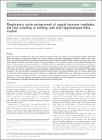| dc.contributor.author | REILLY, RICHARD | en |
| dc.contributor.author | O'MARA, SHANE | en |
| dc.date.accessioned | 2015-03-04T14:03:06Z | |
| dc.date.available | 2015-03-04T14:03:06Z | |
| dc.date.issued | 2014 | en |
| dc.date.submitted | 2014 | en |
| dc.identifier.citation | Tsanov M, Chah E, Reilly R, O'Mara SM, Respiratory cycle entrainment of septal neurons mediates the fast coupling of sniffing rate and hippocampal theta rhythm., The European journal of neuroscience, 39, 6, 2014, 957-74 | en |
| dc.identifier.other | Y | en |
| dc.identifier.uri | http://hdl.handle.net/2262/73410 | |
| dc.description | PUBLISHED | en |
| dc.description.abstract | Memory for odour information may result from temporal coupling between the olfactory and hippocampal systems. Respiration
defines the frequency of olfactory perception, but how the respiratory rate affects hippocampal oscillations remains poorly under-
stood. The afferent connectivity of the medial septum/diagonal band of Broca complex (MS/DB) proposes this region as a cross-
roads between respiratory and limbic pathways. Here we investigate if the firing rates of septal neurons integrate respiratory rate
signals. We demonstrate that approximately 50% of MS/DB neurons are temporally correlated with sniffing frequency. Moreover,
a group of slow-spiking septal neurons are phase-locked to the sniffing cycle. We show that inter-burst intervals of MS/DB theta
cells relate to the sniff rate. Intranasal odour infusion evokes sniff phase preference for the activity of fast-spiking MS/DB neurons.
Concurrently, the infusion augments the correlation between sniffing and limbic theta oscillations. During periods of sniffing
–
theta
correlation, CA1 place cells fired preferentially during the inhalation phase, suggesting the theta cycle as a coherent time frame
for central olfactory processing. Furthermore, injection of the GABAergic agonist muscimol into medial septum induces a parallel
decrease of sniffing and theta frequencies. Our findings provide experimental evidence that MS/DB does not merely generate
theta rhythm, but actively integrates sensorimotor stimuli that reflect sniffing rate. Such integration may provide temporal oscilla-
tory synchronisation of MS/DB-innervated limbic structures with the sniffing cycle. | en |
| dc.description.sponsorship | We thank Mani Ramaswami and James Knierim for helpful comments on
early versions of the manuscript. This work was supported by Science Foun-
dation Ireland, the Health Research Board and the Wellcome Trust under the
Biomedical Research Partnership, grant number 099926/Z/12/Z to M.T. The
authors declare no competing
fi
nancial interests | en |
| dc.format.extent | 957-74 | en |
| dc.language.iso | en | en |
| dc.relation.ispartofseries | The European journal of neuroscience | en |
| dc.relation.ispartofseries | 39 | en |
| dc.relation.ispartofseries | 6 | en |
| dc.rights | Y | en |
| dc.subject | odour information | en |
| dc.subject.lcsh | odour information | en |
| dc.title | Respiratory cycle entrainment of septal neurons mediates the fast coupling of sniffing rate and hippocampal theta rhythm. | en |
| dc.type | Journal Article | en |
| dc.contributor.sponsor | Science Foundation Ireland (SFI) | en |
| dc.type.supercollection | scholarly_publications | en |
| dc.type.supercollection | refereed_publications | en |
| dc.identifier.peoplefinderurl | http://people.tcd.ie/reillyri | en |
| dc.identifier.peoplefinderurl | http://people.tcd.ie/smomara | en |
| dc.identifier.rssinternalid | 99520 | en |
| dc.identifier.doi | http://dx.doi.org/ 10.1111/ejn.12449 | en |
| dc.rights.ecaccessrights | openAccess | |
| dc.subject.TCDTheme | Ageing | en |
| dc.subject.TCDTheme | Neuroscience | en |
| dc.subject.TCDTheme | Next Generation Medical Devices | en |




